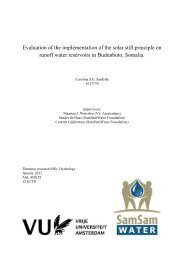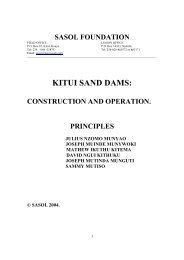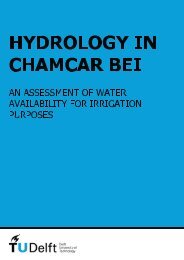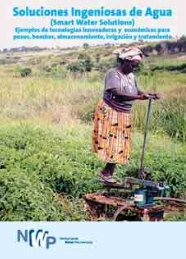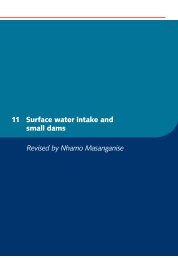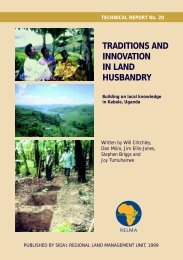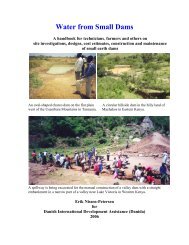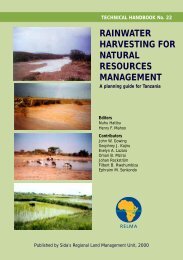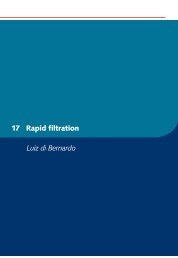Hydrogeology and siting of micro-dams around Léo Burkina Faso
Hydrogeology and siting of micro-dams around Léo ... - SamSamWater
Hydrogeology and siting of micro-dams around Léo ... - SamSamWater
Create successful ePaper yourself
Turn your PDF publications into a flip-book with our unique Google optimized e-Paper software.
<strong>Hydrogeology</strong> <strong>and</strong> <strong>siting</strong> <strong>of</strong> <strong>micro</strong>-<strong>dams</strong> <strong>around</strong> <strong>Léo</strong>, <strong>Burkina</strong> <strong>Faso</strong>14 June 20107 Conclusions <strong>and</strong> recommendations7.1 Hydrogeological assessment <strong>of</strong> the <strong>micro</strong>-<strong>dams</strong>At the <strong>micro</strong>-dam site <strong>of</strong> Sanga the hydrogeology <strong>around</strong> the <strong>micro</strong>-dam is characterised by threeaquifers:- a shallow aquifer consisting <strong>of</strong> (river)sediments <strong>and</strong> weathering products (clay, s<strong>and</strong>y silts <strong>and</strong>laterite), most scoopholes are dug into this first aquifer- under the (river)sediments the weathered hard rock zone makes up a second aquifer, most openwells are dug into this aquifer- below the weathered hard rock the fractures <strong>of</strong> the underlying hard rock make up a third aquifer,most boreholes (forages) are drilled into this aquifer.Based on field observations <strong>and</strong> drill logs it is presumed that this situation is representative for theother <strong>micro</strong>-dam sites <strong>and</strong> proposed <strong>micro</strong>-dam sites in the area <strong>around</strong> <strong>Léo</strong>.The first aquifer is directly recharged by the surface water reservoir created by the <strong>micro</strong>-dam. Fromthis top layer <strong>of</strong> sediments, the water will slowly seep downward <strong>and</strong> recharge the second aquifer(weathered hard rock). From the weathered hard rock the water will also flow into the cracks <strong>and</strong>fractures <strong>of</strong> the third aquifer (fractured hard rock), but in which rate <strong>and</strong> to what extend this willhappen depends on the local geological situation (where are the cracks, are they interconnected, etc.).Since the end <strong>of</strong> the last rainy season (October 2009) until the time <strong>of</strong> the field visit (February 2010)the water level in the reservoir upstream <strong>of</strong> the <strong>micro</strong>-<strong>dams</strong> has dropped because <strong>of</strong> evaporation,water use (mainly by cattle <strong>and</strong> for brick making) <strong>and</strong> infiltration <strong>of</strong> water into the ground. About 1/3<strong>of</strong> the drop in water level is caused by evaporation, 1/3 by water use by cattle <strong>and</strong> brick making <strong>and</strong>1/3 because <strong>of</strong> infiltration into the ground. The amount <strong>of</strong> infiltration depends on the localpermeability <strong>and</strong> clogging <strong>of</strong> the soil near the dam <strong>and</strong> varies from site to site.Since surface water from the reservoir infiltrates into the ground all year round (since there is surfacewater upstream <strong>of</strong> the dam all year round) the <strong>micro</strong>-dam increases the groundwater recharge <strong>and</strong>availability: usually the amount <strong>of</strong> infiltration is larger than the volume stored in the surface waterreservoir. This groundwater could be a significant source <strong>of</strong> safe (drinking) water. In the case <strong>of</strong> Sanga(700 inhabitants that live in the surroundings <strong>of</strong> the dam) the amount <strong>of</strong> recharge by the <strong>micro</strong>-dam isequal to more than 50 liter per person per day (all year round). The amounts at other (potential)<strong>micro</strong>-dam sites will be comparable. The actual amount <strong>of</strong> available ground water will depend on theinfiltration rate <strong>of</strong> the soil near the dam, the surface area <strong>of</strong> the reservoir (height <strong>of</strong> the dam <strong>and</strong> thewidth <strong>and</strong> gradient <strong>of</strong> the riverbed) <strong>and</strong> the recoverability.A main issue regarding the <strong>micro</strong>-<strong>dams</strong> is their objective. On the one h<strong>and</strong> the purpose <strong>of</strong> a <strong>micro</strong>damis provide a year round source <strong>of</strong> surface water which can be used for cattle, brick making,washing <strong>and</strong> irrigation, while on the other h<strong>and</strong> the <strong>dams</strong> recharge the groundwater. Thisgroundwater is currently mainly being used for irrigation <strong>and</strong> (at some sites) as drinking water. Thelarger the amount <strong>of</strong> groundwater recharge, the more groundwater will be available, but this willreduce the amount <strong>of</strong> surface water. The dilemma that CREDO <strong>and</strong> the villagers had at Sanga whetheror not to remove the clay upstream <strong>of</strong> the dam to increase the infiltration rate is a clear example <strong>of</strong>the opposed interests.CREDO advises the villagers not to drink the water from open wells since they are contaminated bythe buckets <strong>and</strong> ropes used to fetch the water. Although CREDO advises not to, at most locationspeople still use this water for drinking. Either because it is more convenient (more nearby, less busy)or because it tastes better.At most sites there is a borehole available for drinking water supply in the village near the dam. Most<strong>of</strong> these boreholes are intensively used for human drinking water. But when there is no more surfacewater available during the dry season, even the cattle has to drink from these boreholes making themeven more busy.The direct effect <strong>of</strong> a <strong>micro</strong>-dam on the drinking water in the boreholes will probably be small sincethe boreholes are hundreds <strong>of</strong> meters away from the dam <strong>and</strong> 40 to 60 meters deep. The boreholesget their water from the fractures in the hard rock which are <strong>of</strong>ten non-continuous. But this doesn’t30




